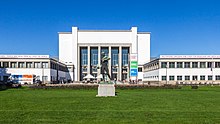German Hygiene Museum

Entrance area
|
|
| Established | 1912 |
|---|---|
| Location | Lingnerplatz 1 01069 Dresden, Germany |
| Type | Medicine, health promotion |
| Visitors | 280,000 |
| Website | dhmd.de |
The German Hygiene Museum (German: Deutsches Hygiene-Museum) is a medical museum in Dresden, Germany. It conceives itself today as a "forum for science, culture and society". It is a popular venue for events and exhibitions, and is among the most visited museums in Dresden, with around 280,000 visitors per year.
The museum was founded in 1912 by Karl August Lingner, a Dresden businessman and manufacturer of hygiene products, as a permanent "public venue for healthcare education", following the first International Hygiene Exhibition in 1911.
The second International Hygiene Exhibition was held in 1930/31, in a building erected west of the Großer Garten park according to plans designed by Wilhelm Kreis, which became the museum's permanent home. One of the biggest attractions was, and remains, a transparent model of a human being, the Gläserner Mensch or Transparent Man, of which many copies have subsequently been made for other museums.
During the Third Reich the museum came under the influence of the Nazis, who used it to produce material propagandising their racial ideology and promoting eugenics. Various Nazi government offices relocated to the museum between 1933 and 1941, and the German Labour Front's Reichsberufswettkampf (National Vocational Competition) was held there in 1944. Large parts of the building and collection were destroyed by the bombing of Dresden in 1945.
In the GDR-era the museum resumed its role as a communicator of public health information. Following reunification the museum was reconceived and modernised, starting in 1991. In 2001 it was included in the German government's Blue Book, a list of around 20 so-called "Cultural Lighthouses" – cultural institutions of national importance in the former East Germany – in an association called the KNK. Between 2001 and 2005 the museum was renovated and partly rebuilt under the architect Peter Kulka.
...
Wikipedia
